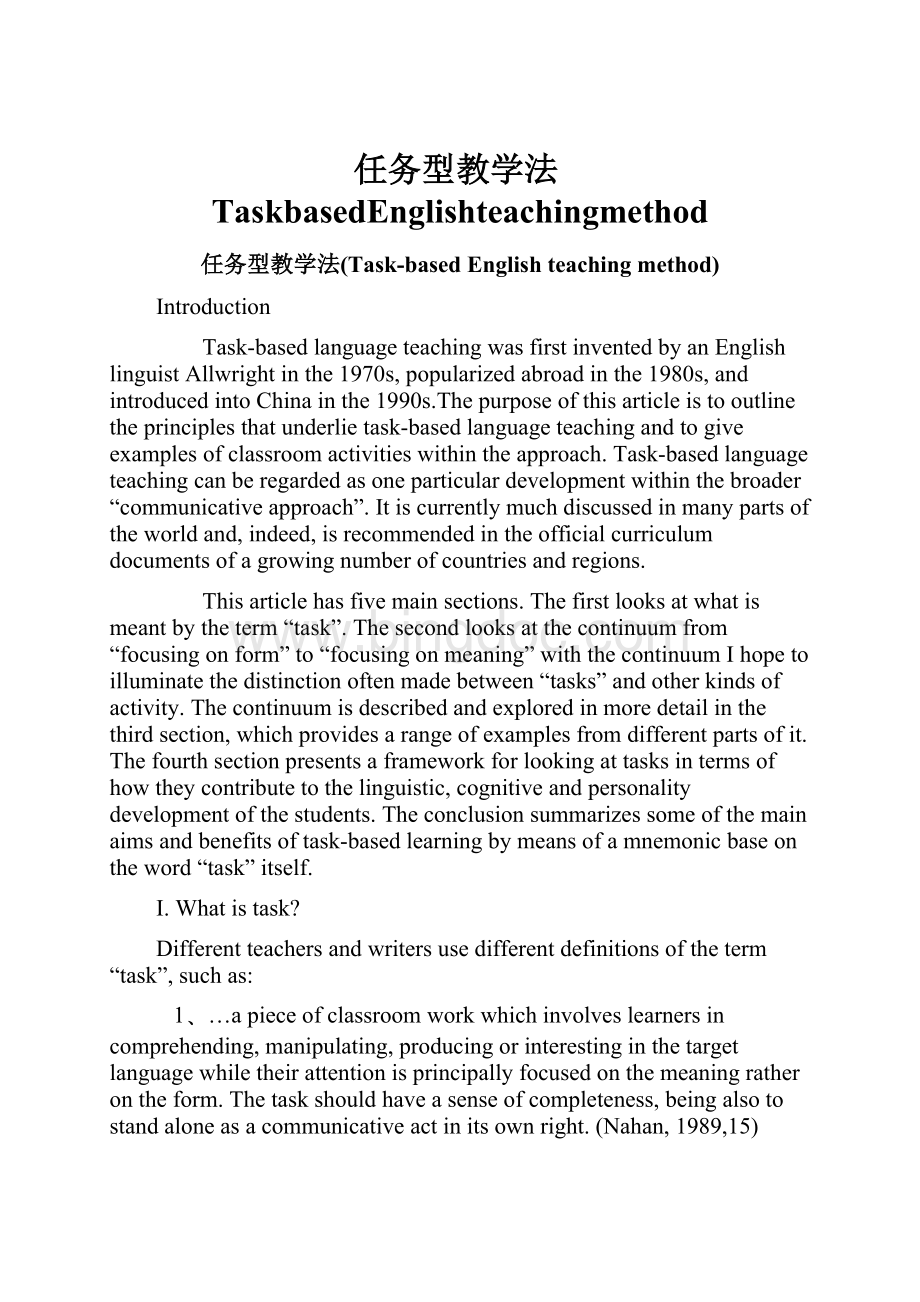任务型教学法TaskbasedEnglishteachingmethod.docx
《任务型教学法TaskbasedEnglishteachingmethod.docx》由会员分享,可在线阅读,更多相关《任务型教学法TaskbasedEnglishteachingmethod.docx(14页珍藏版)》请在冰点文库上搜索。

任务型教学法TaskbasedEnglishteachingmethod
任务型教学法(Task-basedEnglishteachingmethod)
Introduction
Task-basedlanguageteachingwasfirstinventedbyanEnglishlinguistAllwrightinthe1970s,popularizedabroadinthe1980s,andintroducedintoChinainthe1990s.Thepurposeofthisarticleistooutlinetheprinciplesthatunderlietask-basedlanguageteachingandtogiveexamplesofclassroomactivitieswithintheapproach.Task-basedlanguageteachingcanberegardedasoneparticulardevelopmentwithinthebroader“communicativeapproach”.Itiscurrentlymuchdiscussedinmanypartsoftheworldand,indeed,isrecommendedintheofficialcurriculumdocumentsofagrowingnumberofcountriesandregions.
Thisarticlehasfivemainsections.Thefirstlooksatwhatismeantbytheterm“task”.Thesecondlooksatthecontinuumfrom“focusingonform”to“focusingonmeaning”withthecontinuumIhopetoilluminatethedistinctionoftenmadebetween“tasks”andotherkindsofactivity.Thecontinuumisdescribedandexploredinmoredetailinthethirdsection,whichprovidesarangeofexamplesfromdifferentpartsofit.Thefourthsectionpresentsaframeworkforlookingattasksintermsofhowtheycontributetothelinguistic,cognitiveandpersonalitydevelopmentofthestudents.Theconclusionsummarizessomeofthemainaimsandbenefitsoftask-basedlearningbymeansofamnemonicbaseontheword“task”itself.
Ⅰ.Whatistask?
Differentteachersandwritersusedifferentdefinitionsoftheterm“task”,suchas:
1﹑…apieceofclassroomworkwhichinvolveslearnersincomprehending,manipulating,producingorinterestinginthetargetlanguagewhiletheirattentionisprincipallyfocusedonthemeaningratherontheform.Thetaskshouldhaveasenseofcompleteness,beingalsotostandaloneasacommunicativeactinitsownright.(Nahan,1989,15)
2﹑…anystructuredlanguagelearningendeavorwhichhasaparticularobjectiveappropriatecontents,aspecifiedworkingprocedure,andrangeofoutcomesforthosewhoundertakethetask.(BreenviaBrown,1994,83)
3﹑…anactivitywhichisdesignedtohelpachieveaparticulargoal.Anumberofdimensionsoftasksinfluencetheiruseinlanguageteaching.(RichardsEtal,2000,468)
Mostpeoplewouldprobablyagreeoncertainbasiccharacteristics:
1﹑Tasksareactivitiesinwhichstudentsworkpurposefullytowardsanobjective.
2﹑Theobjectivemaybeonethatstudentshavesetforthemselvesoronewhichhasbeensetbytheteacher.
3﹑Tasksmaybecarriedoutincompetitionwithotheror(moreoften)incollaboration.
4﹑Theymaybecarriedoutindividuallyor(moreoften)ingroups.
5﹑Theoutcomemaybesomethingconcrete(e.g.areportorpresentation)orsomethingintangible(e.g.agreementorthesolutiontoaproblem).Themainareaofdisagreementrevolvesaroundtherelationshipbetweentasksandcommunication.Someteachersandwritersdonotseethisrelationshipascrucial.Theydefinealanguagelearningtaskasincludingalmostanythingthatstudentsareasked(orchoose)todointheclassroom,includingformallearningactivitiessuchasgrammarexercisesandcontrolledpracticeactivities,providedtheobjectiveoftheactivityisrelatedtolearningthelanguage.
Withinthisbroaddefinition,somewritersdistinguishsubcategoriessuchascommunicationtasksandenablingtasksaccordingtotheextenttowhichtheyinvolvecommunicationorfocusonform.
Manyotherteachersandwritersuseamorerestricteddefinition.Theyexcludeactivitieswherethelearnersfocusonformalaspectsofthelanguage(suchasgrammar,pronunciationorvocabulary)andreservetheterm“task”foractivitiesinwhichpurposeisrelatedtothecommunicationofmeanings.Willis(1996,p.23)isonewriterwhoadoptsthisdefinition.Inthisbooktasksarealwaysactivitieswherethetargetlanguageisusedbythelearnerforacommunicativepurpose(goal)inordertoachieveanoutcome.
Activitieswhichfocusuponandpracticespecificelementsofknowledge,skillsandstrategiesneededforthetaskarecalledexercises.ThesamedistinctionbetweentasksandexercisesissupportedbyEllisNunanandSkehan.Skehan,forexample,describesthecriteriaforataskasfollows:
1﹑meaningisprimary;2﹑thereissomecommunicationproblemtosolve;3﹑thereissomesortofrelationshiptoreal-worldactivities;4﹑taskcompletionhassomepriority;5﹑theassessmentofthetaskisintermsofoutcome.
Thedefinitionreflectsthemethod’sinteractionbutwecan’tmakeaclear-cutdistinctionbetween“task”and“exercises”.Thiswillbediscussedinthenextsection.
Ⅱ﹒Communication,TasksandExercises.
Aswe’veseen,oneofthekeyfeaturesofacommunicativetaskisthatcentersfocusoncommunicatingmeaningsratherthanlearningorpracticingforms.Howeveritisnotusuallysimplyaquestionoflearningfocusingeitheronmeaningoronform.Moreoften,itisamatter ofdegree.Forexample,therearesomeactivitiesinwhichthelearnermayfocusmainlyontheproductionofcertainformsthatarebeingpracticed,butheorshemastillbeusingtheseformstoconveymeaningstosomebody.Thiswouldbethecasein,forexample,this“Questionnairesurvey”activity,inwhichthestudentsneedstouse“canyou…?
”inordertofindclassmateswhocandocertainthings,suchas:
whocanspeakthreelanguages/useacomputer/makecakes/rideabike/swim?
Inthisactivity,althoughthestudentshaveacommunicativepurpose(tofindclassmateswithparticularskills)itisalsoclearthattheyarepracticingspecificforms.Atothertimes,theemphasisoncommunicatingmeaningsmayincreasebutstudentsmaystillpayattentiontotheformstheyareproducing(andwhichindeed,theymayjusthavebeentaught).Thismightbethecaseinthisroleplayifstudentsareaskedtoperformitshortlyafterlearninghowtomakeenquiriesandgiveinformationabouthotelaccommodation.Eachstudenthasoneofthefollowingrolecards:
studentA:
Youarriveatasmallhoteloneevening.Inthefoyer,youmeetthemanager(ess)and1.Askifthereisaroomvacant.2.Asktheprice,includingthebreakfast.3.Sayhowmanynightsyouwouldliketostay.4.Saywhattimeyouwouldliketohavebreakfast;studentB:
Youarethemanager(ess)ofasmallhotelthatpridesonitselfonitsfriendly,homelyatmosphere.Youhaveasingleandadoubleroomvacantfortonight.Thepricesare:
$100forthesingleroom,$160forthedoubleroom.Breakfastis$15extraperperson.Forguestswithcars,thereisafreecarpark.Sinceitisimpossibletodrawacleardividinglinebetweenactivitieswherethefocusisonform(exercise)andactivitieswherethefocusisionmeaning(task),itisusefultothinkofacontinuumwithvaryingdegreesoffocusonformand/ormeaning.Activitiescanthenbeclassifiedaccordingtowheretheyliealongthiscontinuum.Thecontinuumisdividedintofivesections.FromsectionⅠtosectionⅤ,thecontentfromformstomeaningisbecomingstrongerandstronger.1. Non-communicativelearning.Focusingonthestructuresoflanguage,howtheyareformedandwhattheymean,e.g.throughexercise,“discovery”andawareness-raisingactivities.2.Pre-communicativelanguagepractice. Practicinglanguagewithsomeattentiontomeaningbutnotcommunicatingnewmessagestoothers,e.g.in“question-and-answer”practice.3.Communicativelanguagepractice.Practicinglanguageinacontextwhereitcommunicatesnewinformation,e.g.informationgapactivitiesorpersonalizedquestions.4.Structuredcommunication.Usinglanguagetocommunicateinsituationswhereelicitpre-learntlanguagebutwithsomeunpredictability,e.g.instructuredrole-playandsimpleproblem-solving.5.Authenticcommunication.Usinglanguagetocommunicateinsituationswheremeaningsareunpredictable,e.g.increativerole-play,morecomplexproblem-solvinganddiscussion.Theactivitiesatthetopareobviously“exercises”.Thoseatthebottomareobviously“tasks”.Thoseinthemiddle(2-4)havefeaturesofboth.
Ⅲ.FromNon-CommunicativeLearningtoAuthenticCommunication.
Thesectionwillelaborateonthepreviousonebygivingexamplesofactivitiesfromfivepartsofthecontinuumfrom“focusonform”to“focusonmeaning”.Inthetermsdiscussedabove,thiscorrespondsalsotoaprogressionfromclearlydefined‘exercises”toclearlydefined“tasks”.
1. Non-CommunicativeLearning.
Itisinthiscategorythatthereistheleastelementofcommunication.Here,forexample,studentsareinvolvedin“discovering”aruleofgrammaronthebasisofexamples.Intheexamplesbelow,lookcarefullyatthepositionoftheadverbs“always”,“often”,“sometimes”,“usually”,and“never”.
Whataretherules?
A. Weareusuallyhungrywhenwecomehome.
Johnisalwayslate.
Hisparentswereoftentiredintheevening.
Ineversurewhetherthiswordiscorrect.
B. IsometimesgotothecinemaonFridays.
Wenevereatmuchinthemorning.
Janeoftenarrivesatschoolearly.
Theyalwayscomehomelateatnight.
C. Theyhaveneverwrittentomeagain.
Youcanalwayscomeandvisitme.
Iwillneverknowwhyhedidit.
Pathasoftenseenhimwithtwodogs.
Thestudentsarethenrequiredtoapplythisruletoanewsetofexamples:
Puttheadverbsintotherightplacesinthesentencebelow.
A. Weplayfootballintheevening(often).
Icancatchthefirstbusinthemorning(never).
JackandJillareveryhappy(always).
Theyvisitme(sometimes).
YouwriteverygoodEnglish(usually).
B. TheyhavebeentoJinan(often).
Wedrinkteaforbreakfast(always).
Youarecheerful(usually).
Johncankeepasecret(never).
Hehasrefusedtospeaktome(sometimes)
2. Pre-CommunicativeL